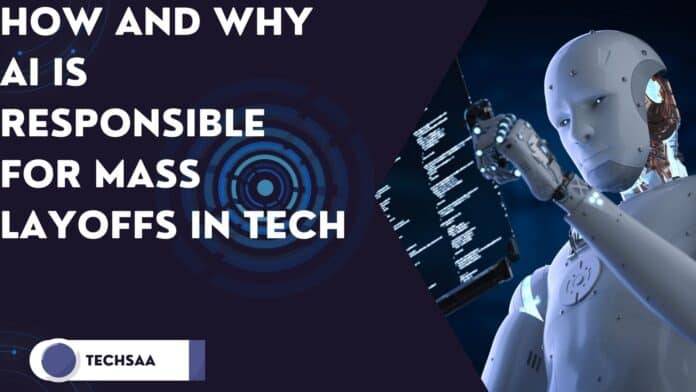With the emergence of artificial intelligence (AI), tremendous changes have swept through every field. In this tech world, where AI promises efficiency innovation and economic growth, mass layoffs in tech have also resulted. This is because automation requires increased reliance on AI solutions and changing market requirements.
Let’s take a deeper look at how and why AI causes Mass Layoffs in Tech.
The Rise of AI in the Tech Industry
AI technologies such as machine learning, natural language processing, and robotics have become popular in the tech world. Companies are investing heavily in AI to streamline operations, improve customer interactions, and compete effectively.
Key Points:
- Cost savings and efficiency brought about by AI adoption throughout various industries.
- Automation is growing important in software development, customer service, and data operations.
- Tech giants like Google, Amazon, and Microsoft are driving advancement in AI research deployment.
Automation and Job Redundancy
Automation, powered by AI, replaces human jobs. Processes that were once fulfilled by human labor are now carried out automatically, eliminating the need for large work units.
Key Points:
- AI replaces routine jobs devoted to programs, such as data entry, testing, and debugging.
- Jobs are shed with automation in data security, cloud computing, and quality control.
- AI tools like Copilot are used to write code and automate software development.
Shifting Skill Demands
As AI advances, tech companies are turning from traditional positions to AI-related occupations. This shift has left many workers out on the road after they provided their service, no matter where they were working and what they were doing. But this is by no means it; there is a party line. The real reason is that for every AI job, demand far outstrips supply, with so few candidates fit for duty in an appropriate role.
Traditional tech roles, including software testing system administrator and coding by hand, have been in decline.
Companies That Priorities AI-Related Competencies Leave Employees No Choice But To Reskill Or Leave Economic Pressures and Cost-Cutting
Economic recession also forces the hands of technology companies when it comes to reducing costs. Markets collapsing during global crises mean that AI tools become a very attractive cost-cutting strategy, often involving layoffs for workers in favor of automation.
Key Points:
- AI-driven Workplace Tools Enable Technology Companies to Cut Costs Through Automation
- With fewer employees, an AI-driven approach can help improve office efficiency.
- It’s startups and small businesses that will turn first to AI as a means of saving money. AI as a Scalability Solution
Companies that want to scale up their business quickly are now turning their attention to AI. By implementing AI-driven processes, organizations can grow, but an additional person isn’t needed in every instance.
Key Points:
- AI allows them to expand production globally without taking on much more labor.
- Using automation, companies are able to handle higher workloads without hiring additional staff.
- In this new world, customer service chatbots, AI-powered IT support, and AI-driven work management tools will all replace people.
AI in Customer Support and Administrative Roles
The area of technology in which AI has made the greatest impact is undoubtedly customer services: AI chat, virtual assistants, and even automated helpdesks, whereby fewer and fewer humans need to work with clients.
Key Points:
- Chatbots powered by AI, as well as virtual assistants, have replaced many customer service agents.
- Administrative actions, such as scheduling and documentation, which are now performed using a computer program, no longer require human labor.
- The cost-cutting tool used most frequently by him is now an AI-driven customer experience program!
The Future: AI Augmentation vs. Job Replacement
Although AI has led to many people losing their jobs, only some posts are lost permanently. AI is increasingly being used to enhance, not obliterate, human labor. Future workforces may consist of hybrid teams where humans and AI both play a part.
Key Points:
- AI can supplement human productivity, not replace it.
- New professions with titles like AI ethics officer and AI maintenance engineer are emerging.
Learning about AI is important for people in the computer tech field who want to stay relevant and stay caught up. Nothing else will do when automation hits at every level, costs are squeezing us from every direction, skills required at one point in time might not be needed anymore, and it might be too late to adapt.
Conclusion
Mass layoffs in tech are a massive signal – for economic uncertainty, over-hiring during the pandemic, and slowing growth – but also point to imitative behavior across the sector. Factoring in the fact that such layoffs may not necessarily cut costs or improve company performance in the long term adds another layer of complexity to it all. Moreover, the human cost of layoffs is not only increased stress but also lowered morale that affects both the laid-off employee and the balance of those who will remain.

